|
|
Gary Novak
Why Global Warming Science is Nothing but Fraud Saturation, Proof of Climate Science Fraud Fudge Factor for Settled Science Fakery of the Primary CO2 Effect
Crunching the Numbers Absorption Spectra Explanations Simple Words Contrivance Communication Corruption Alphabetical Page List And Summaries
The Cause of Ice Ages and Present Climate |
Primary and Secondary Effects Originally, there was no concept of secondary effects, because secondary effects are absurd. Therefore, early publications, such as Charney et al, 1979 and Ramanathan et al, 1979 make no mention of secondary effects—they simply address a total effect. Since the complexities of climatology defy scientific analysis, a fake result was contrived by looking at the past and claiming something similar would happen in the future. The problem was, the assumed past only pointed to a 1°C temperature increase upon doubling carbon dioxide in the atmosphere. Journalists were saying they would not be concerned about such a small temperature increase; it would need to be 3 or 4°C to be relevant. So climatologists added a concept of secondary effects through feedback to get a larger number. There are infinite contradictions in attempting to add a secondary effect to a primary effect. Any ability to define a primary effect disappears. What climatologists did was take the previous number, when no one was assuming a secondary effect, and built upon it as a primary effect. That number was analyzed and described as if it were the total effect. So the previously assumed total effect became the primary effect. It was published as approximately 3 ±0.5°C. This would have been just what alarmist climatologists were looking for, except it would not stand up to criticism, because the past was pointing to only 1°C. So the 3°C was whittled back to 1°C, while a claimed secondary effect pushed it back up to 3°C. How come there was no secondary effect pushing the past temperature up? If there was, what would the primary effect be? Some say the past primary effect was 0.2°C with a tripling by the past secondary effect to 0.6°C. But this logic defeats the new concept of a secondary effect, which is supposed to get the temperature up to 3°C with doubling of CO2. So the result builds upon a past secondary effect to create a new primary effect and then adds another secondary effect upon the first. This is like the woman going into a butcher shop to buy chicken. The butcher shows her a chicken, and she asks how much it weights. He says one pound. She asks if he has a two pound chicken. Since he only has one, he puts it under the counter and brings it back up and says, here's a two pound chicken. She says, fine, I'll take them both. Myhre et al, 1998 supposedly produced the definitive determination of the primary effect, which is a fudge factor (5.35 ln C/Co). It's supposedly so precise that they could say that previous determinations were off by 15%. How miraculous for chasing every molecule through the atmosphere for the past thousand years and the next hundred years. If only the weather forecasters could do that. The Myhre group did two types of analysis: They used radiative transfer equations and then evaluated something in the atmosphere—no clarification. Since radiative transfer equations have the purpose of evaluating the depletion of radiation through varying concentrations of a gas, the atmospheric analysis was implicitly a method of determining how heat results from radiation depletion. These vagaries raise questions of what the primary effect is supposed to be. The implication of using radiative transfer equations is that each photon which is absorbed by a molecule of carbon dioxide will produce some heat, and then various things modify the result in the atmosphere. Is then the primary effect the result of photons being absorbed by carbon dioxide, or is it the total result after the atmosphere adds some influence? There are three areas of concern—1. the absorption of radiation by CO2, 2. the influence of the atmosphere, and 3. feedback effects which amplify the result. The appearance from the superficial publication of Myhre et al, 1998, is that the first two effects are combined to create the primary effect indicated by the fudge factor. This results in the atmosphere influencing both the primary effect and the secondary effect. How does science differentiate between primary effects of the atmosphere and secondary effects of the atmosphere? Those differences cannot be defined or measured. They are modeled, but modeling is nothing resembling science. Flat earthers wonder about these things.
|
|||||||||||||
 | ||||||||||||||

